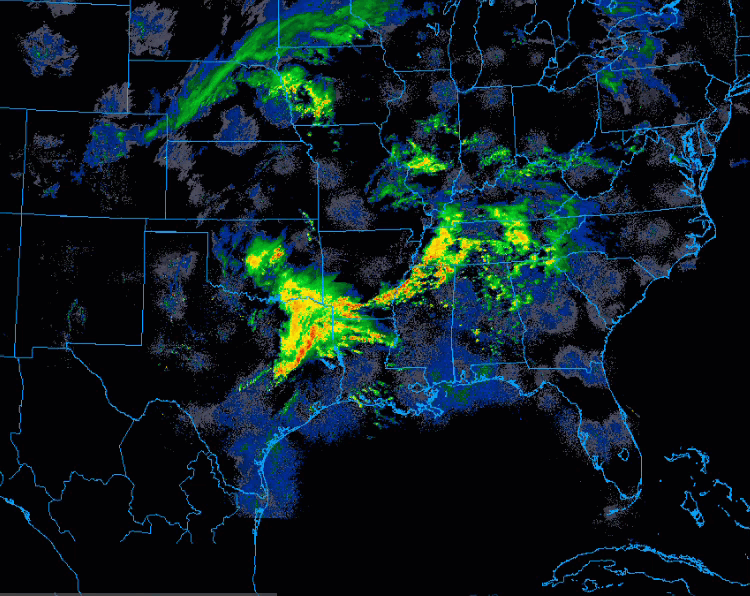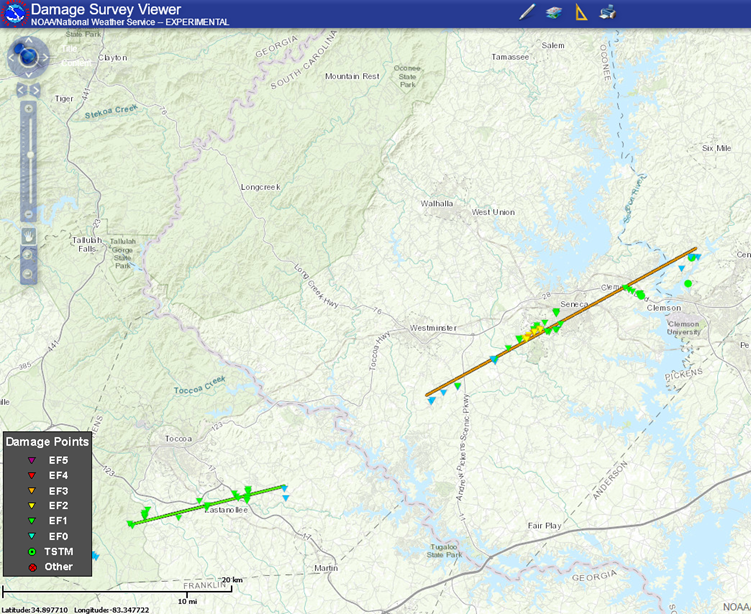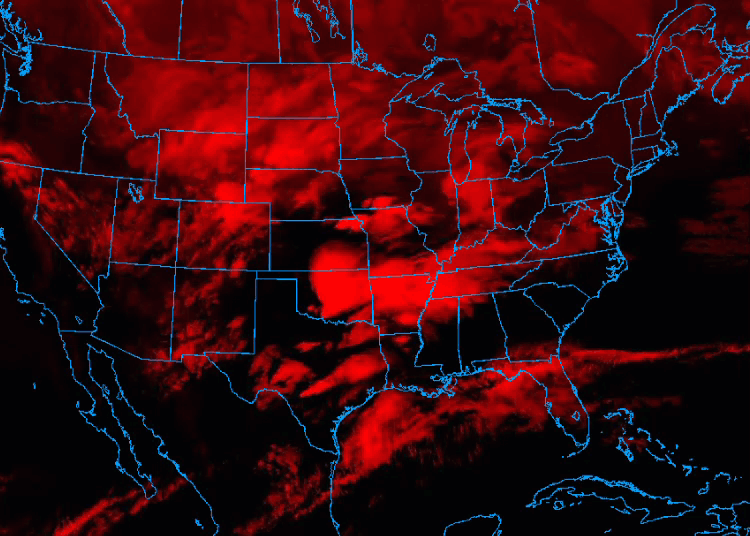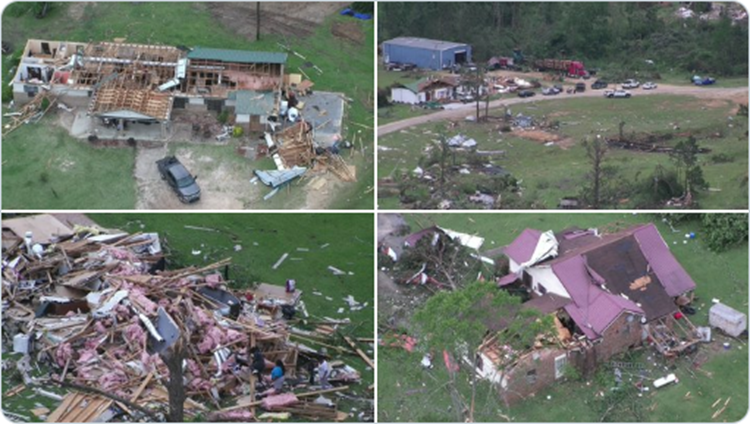
Weekend severe thunderstorm activity has affected areas from the Southern Plains to the Atlantic Coast, with especially severe activity reported Sunday, April 12. In particular, several long-track, destructive tornadoes were reported including a confirmed EF-3 crossing portions of Monroe, Louisiana, another EF-3 near Clemson, South Carolina and two significant tornadoes reported north of Hattiesburg, Mississippi. U.S. Storm Prediction Center (SPC) reports of damaging straight-line winds were also widespread from the Southern Plains to the Atlantic coast, along with some hail reports. Numerous homes have suffered complete destruction by significant tornadoes. Light to moderate structural damage has also been reported for homes affected by straight-line winds and hail. Reports of downed trees and powerlines are widespread, along with numerous reports of power outages. At least 34 fatalities have been reported by media, and our thoughts and concerns are with those lost or directly affected by this event.
Meteorological Discussion
The severe thunderstorm activity was enabled by the presence of very warm, unstable air, abundant moisture from the Gulf of Mexico and changing wind speed and direction with height as a strong upper-level system approached the area from the west. Thunderstorm activity initiated in this environment ahead of a strong frontal system as it crossed from the Southern Plains to the Northeast. A developing frontal boundary with embedded areas of low pressure over the Northern Gulf states produced additional forcing and mechanics, to initiate severe thunderstorms in this ideal environment. Thunderstorm activity developed over the Southern Plains on Saturday with a primary threat of large hail. Significant hail of two inches or more was reported in Texas, Oklahoma, Kansas and Nebraska according to the SPC, with reports of 4-inch diameter hail in Kinney and Val Verde Counties, Texas (in the Del Rio area). Some tornado reports and damaging wind gusts were also reported by the SPC on Saturday across central to eastern Texas. On Sunday, an ideal environment developed over the Northern Gulf states to produce long-lived rotating supercell thunderstorms, that produced long-track significant tornadoes and large hail. Significant tornado activity occurred in areas including Monroe, Louisiana, where National Weather Service (NWS) damage assessments confirmed an EF-3 tornado crossing the area. Further east in Mississippi, two apparent significant tornadoes followed similar tracks north of the Hattiesburg area, with evident damage consistent with an apparent EF-3 or possible EF-4 tornado – local NWS damage assessments are ongoing to confirm intensities.

EF-3 Tornado Track Crossing Monroe, Louisiana. Source: NOAA/NWS.

Radar Animation for the Outbreak. Source: weather.cod.edu. In the meantime, as thunderstorm cells organized into quasi-linear segments, a threat for damaging straight-line winds developed, with numerous reports across the southern states. Activity then progressed eastward late Sunday into early Monday affecting portions of Alabama, Georgia, the Carolinas and Virginia. Additional tornado activity was reported including a confirmed EF-3 in Oconee and Pickens Counties, near Clemson, South Carolina.

Tornado Tracks with EF-3 Near Clemson, South Carolina. Source: NOAA/NWS.

Satellite Animation for the Outbreak. Source: weather.cod.edu. As activity progressed to the Atlantic Coast States on Monday, the threat transitioned to damaging straight-line winds as the primary threat, along with a few more reported tornadoes. Numerous reports of tornadoes, damaging straight-line wind gusts and hail occurred with the activity on Monday. Specifics can be found at the SPC (www.spc.noaa.gov).

Severe Thunderstorm Reports April 11-13. Source: NOAA/SPC. Several other tornadoes were reported by the SPC between Saturday and Monday, and NWS damage surveys are ongoing to confirm and rate these tornadoes. Efforts have been impeded by the complexity and scale of activity, the need to prioritize watches and warnings during the period, and necessary protocols given the COVID-19 threat.
Impacts
At least 34 fatalities have been reported by media. Damage surveys are ongoing, but severe, widespread damage has been reported in most affected states stretching from Texas through New Jersey, with hundreds of businesses and homes destroyed. In addition to over 80 tornado reports, hundreds of high wind and hail reports also occurred, along with significant flooding and mudslides in mountainous areas. Homes affected by significant tornadoes suffered severe to complete damage. Those properties affected by hail or straight-line winds suffered light to moderate property damage. Reports of downed trees and powerlines were widespread along with resulting power outages. Power outages from Texas to Maine affected more than 1.2 million customers, with nearly half a million customers without power in the Carolinas Monday morning.
Louisiana
Police in Monroe, Louisiana have reported around 300 homes damaged or destroyed. Multiple planes and buildings sustained significant damage at the Monroe Regional Airport. West Monroe, in particular, saw houses completely leveled. Downed trees and powerlines were also reported by media in at least four parishes throughout the state where the NWS reported tornadoes. Despite significant structural damage, no immediate reports of major injuries or fatalities have been reported at the time of publication. Arkansas At least one fatality was reported by the Jefferson County Emergency Management Director. A number of downed trees and powerlines were also reported by media along with damage to a handful of homes. Mississippi At least eleven fatalities were reported by media in Mississippi, where two long track tornadoes moved across the southern portion of the state north of Hattiesburg. In the town of Soso, major structural damage was reported, including damage to a volunteer fire station, along with numerous injuries. Several hundred homes were damaged across 18 different counties, according to media reports.

Aerial Impacts Imagery from Jefferson-Davis County, Mississippi. Source: MSEMA.
Alabama
In Boaz, the Police Chief reported more than 50 homes and buildings affected, with impacts ranging from minor damage to complete destruction. Significant damage was rendered to a church after lightning caused a fire, where hundreds of people normally would be congregating if COVID-19 restrictions were not in place.
Tennessee
In Hamilton County, more than 150 homes and commercial buildings were damaged, where the local NWS office confirmed EF-3 damage with estimated winds of 145 mph. One of the structures was an Alzheimer’s living facility, where residents were forced to move to a nearby hotel. Across the county, at least 20 people were treated in hospitals, and at least two fatalities have been confirmed. Over 500 first responders were dispatched to conduct a grid search. To the east, Bradley County also suffered severe damage to several homes and a handful of residents were treated in a hospital. Up to six inches of rain fell in areas of the Tennessee Valley.
Georgia
Eight fatalities have been confirmed by media in Georgia. On Monday, two mobile home parks in Murray County, on the Georgia-Tennessee border, suffered extensive damage, with multiple fatalities and more than 20 injured. An additional fatality was reported in Bartlow County from a tree falling onto a home. In Yatesville, a home was blown completely off its foundation into the middle of State Highway 74 from a tornado. In all, nearly 50 people throughout the state were injured and at least 23 homes were destroyed.
Carolinas
Nine deaths have been reported in South Carolina by the Governor, and one has been reported by the Department of Health and Human Services in North Carolina. Early morning tornadoes in South Carolina rendered severe structural damage in multiple areas of the state, including a confirmed EF-3 tornado, which traveled 16 miles through Oconee and Pickens counties, affecting Seneca, which is just west of Clemson University. EF-3 damage was also produced in Neeses and Livingston in Orangeburg County, where winds were estimated at 160 mph. Further south and east, numerous homes were damaged in Hampton County in the areas of Nixville and Estill and in Walterboro, Colleton County, where the NWS confirmed damage to numerous structures, including the Lowcountry Regional Airport. Multiple smaller tornadoes affected North Carolina, including an EF-1 tornado in Alamance County in the central portion of the state. Downed trees also rendered significant property damage in Davidson County. Meanwhile near the coast, EF-1 tornadoes in Pender and Columbus counties were reported, with another EF-0 on Oak Island as a waterspout came ashore.
Mid-Atlantic
Thunderstorm straight-line winds caused widespread damage in the states of Pennsylvania, Maryland, Delaware, New York, and New Jersey on Monday. Downed trees and power lines with resulting power outages, along with variable property damage were reported as a result. Probable wind gusts over 70 mph were reported in multiple locations along the New Jersey and Delaware coasts. Damage was sustained to multiple coastal structures in New Jersey, including the Wildwood Boardwalk, a hotel in Cape May, a gas station in Egg Harbor, and a marina in Somers Point. Wind gusts of 40 mph were reported in downtown Philadelphia, and nearly 400,000 customers were out of power as of Monday evening from Virginia to Massachusetts.
Sources: U.S. Storm Prediction Center (SPC), U.S. National Weather Service (NWS), Associated Press, The Weather Channel, New York Times, weather.cod.edu, Mississippi Emergency Management Agency.